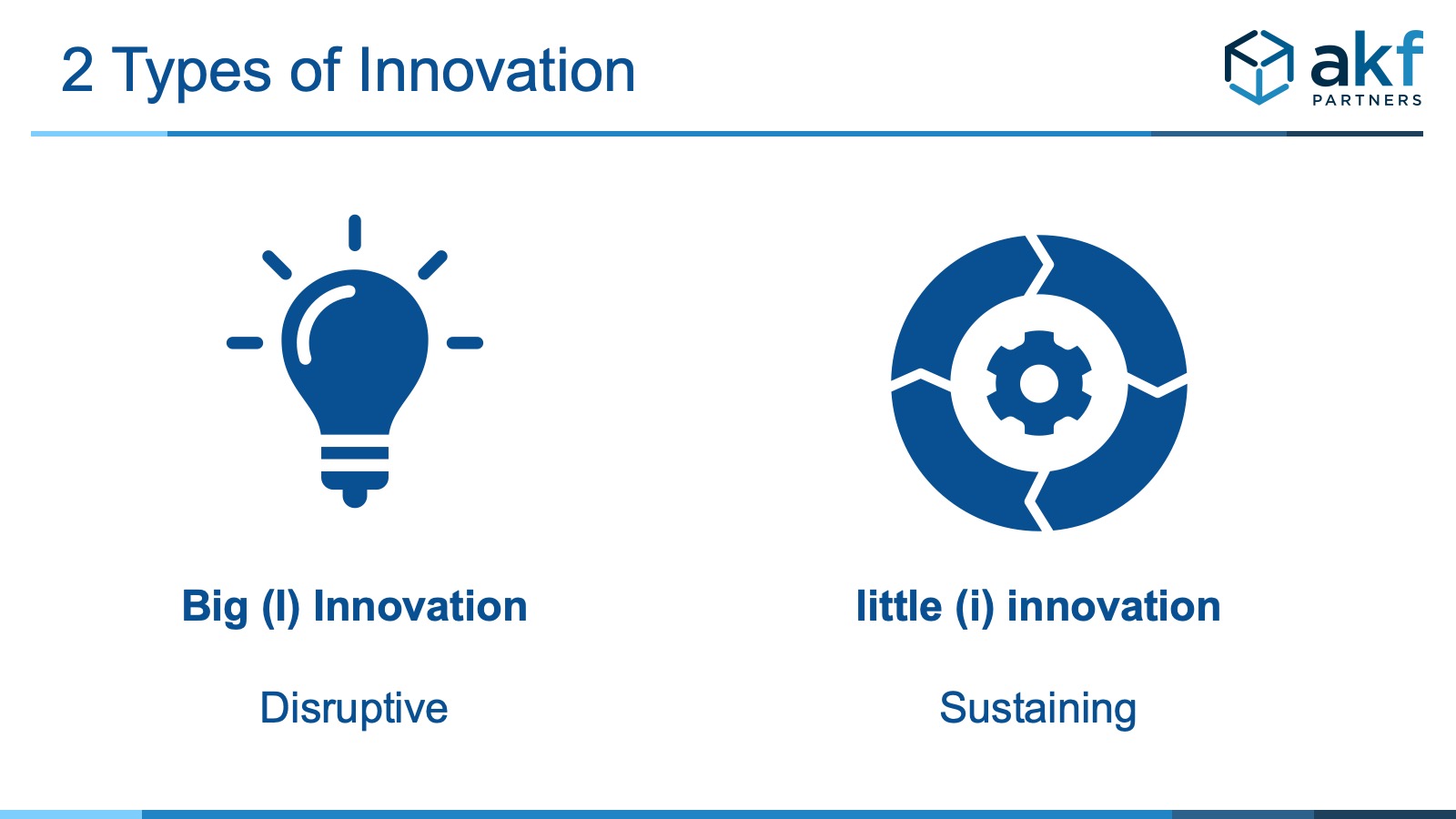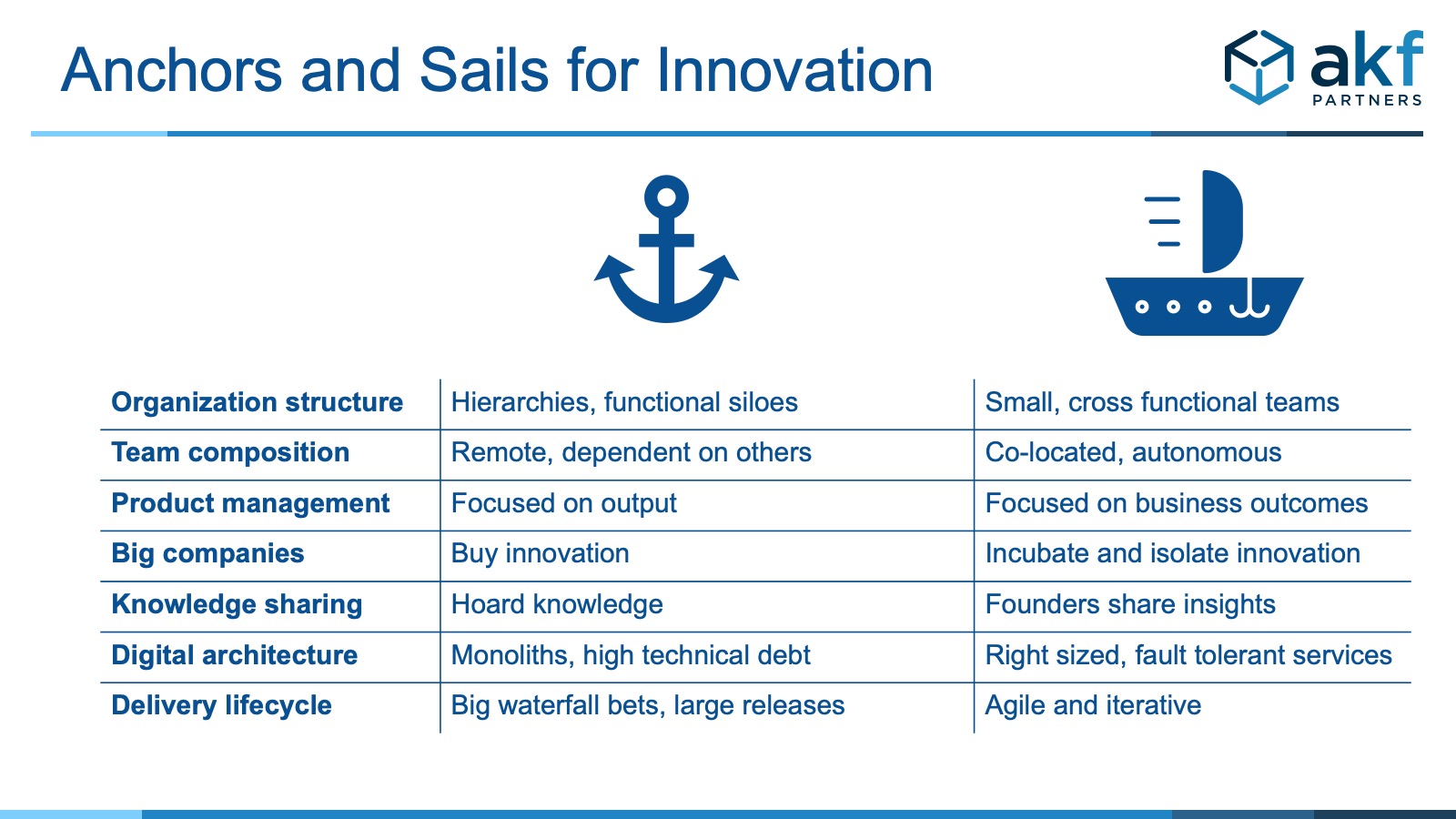
What is Innovation?
To better understand innovation, we identify 2 variations of innovations:
- Disruptive Innovation or Big (I) Innovation - when new products or services create new markets or disrupt existing markets. Most large, successful companies have experienced this Innovation once organically. Peter Drucker observed the vast majority of companies only experience Disruptive Innovation once. These companies then seek to buy (acquire) innovation later as they grow.
- Sustaining Innovation or Little (i) innovation – are typically improvements to processes, products or services to maintain competitive differentiation or improve performance. Little (i) innovation can occur often in companies that no longer create or disrupt markets and can occur along the spectrum of marginal to fairly massive improvements. This more common type of innovation could be a new technology that improves profit margins. This type of innovation could be small – within a team. This type of innovation could be large in scale – impacting several departments. But this does not meet the threshold of disrupting markets.
Big (I) Innovation typically leads to outsized market returns. Think Amazon’s repetitive innovation in ecommerce, logistics, warehousing, digital book distribution, Infrastructure as a Service and Platform as a Service. Each of these drove disruptive solutions against incumbent substitutes. Ecommerce meant people no longer had to drive to brick and mortar retailers. Logistics and Warehousing led to same day or next day deliveries further disrupting the commerce landscape. Digital book distribution disrupted the publishing industry and IaaS/PaaS is in the process of killing the colocation (data center) industry.
Little (i) innovation is also very beneficial for established companies. Little (i) innovation should help with these outcomes:
- Winning new customers
- Retaining valuable customers
- Increasing “share of wallet” of customers
- Higher profit margins (relative to size)
- Attracting, retaining, and developing your workforce
The Digital Age has accelerated both Big (I) Innovation and little (i) innovation.
Big (I) Innovation frequently leads to network effects where first movers can gain majority market shares.
Little (i) innovation can help upstarts catch up and even surpass market incumbents due to faster speed – or what we AKF refer to as time to market (TTM).
Why is Innovation more important in the Digital Age?
Innovation is more important now for 4 reasons:
- Digital experts can move faster than digital laggards. This speed lowers the bar for new entrants. This speed can even overcome regulations for those that introduce Big (I) innovation. For example, Uber quickly penetrated local markets and made the value proposition overwhelmingly clear. Later, Uber influenced regulations that were designed to protect incumbents.
- Digital is difficult to see. Digital is very different from physical goods and services where bottlenecks and customer friction are easy to see. When a concept is difficult to see, it can be difficult to explain and master. This challenge occurs in companies of all sizes. Words and conversations are not helpful for explaining digital – drawings are typically needed explain how 0s and 1s (digital) impact the business.
- Founders and initial experts with market insights are leaving companies earlier. Often these founders are leaving to start another new company using little (i) innovation to penetrate a laggard market. For example, the founder of Zoom was one of the early employees of WebEx.
- COVID made innovation more difficult due to companies shifting to permanent or primarily remote work.

Big (I) Innovation and little (i) innovation have always been important due to the dynamic nature of markets. Markets are never static. Your ability to see, move, and respond to market changes improves your chance of winning.
The Digital Age is accelerating how fast markets move. As such, you likely need to be faster and better at innovation than you were in the past.
Many companies invest heavily in digital, but few can measure improved business outcomes. Many companies cannot see how data flows across teams and departments. Very few executives know how digital slows or accelerates processes. Very few executives understand all of the digital and human touchpoints that a single customer experiences. In spite of employees spending a majority of time in front of computer, few managers know if their employees are productive.
As companies grow and mature, size is not the only obstacle to innovation. The people that best understand current markets and have insights to future markets are usually the original 1-2 founders. Founders are leaving companies earlier due to higher valuations. They are also leaving due to their ability to see and capitalize on new market opportunities.
COVID led to significantly more remote work, particularly for digital companies. Digital companies rely on continual innovation to grow market share. Remote work is generally not as conducive to innovation.
Key Innovation Points for CEOs and Boards
Boards and CEOs need to understand several concepts that can help or hinder continual innovation:
- Organization structure: Small, durable, cross functional, and autonomous teams almost always outperform large organizations for innovation.
- Team composition and location: Co-located cross functional teams outperform distributed functionally silo’d teams. Distributed teams include those that are split on separate floors or in separate parts of the building.
- Product Management: Good Product Manager(s) keep a pipeline of new ideas and test them to prove market viability. Bad Product Managers have rigid roadmaps with fixed dates.
- Common traits of Big Companies that Innovate: The handful of large companies that continue to innovate follow a few patterns. They buy innovation and/or isolate and incubate innovation outside the core business (for the latter point see the works of Christensen, Drucker and Moore).
- Founder knowledge sharing: The original founders must educate new employees into market and product insights.
- Digital Architecture: Your digital architecture may be slowing you down as you scale. Monoliths can slow time to market at scale. Technical debt and aging platforms slow time to market. Drawings are typically needed to explain these concepts.
- Agile vs Waterfall Delivery: Waterfall processes are not designed for digital innovation, they are designed for fixed scope efforts and/or complex supply chains. Agile processes are designed for iterative feedback from real prospects and customers as quickly as possible.
How your organization manages these concepts can be anchors holding you back or sails to propel you forward.

The next section helps you determine if you have innovation anchors or sails in your organization.
Common CEO Questions about Innovation
The CEO needs to be able to answer these questions for both board members and employees:
How fast you respond to market conditions?
Companies that are late movers tend to be rigid process-wise. They also tend to be more inward focusing than outward focusing. Being able to change roadmaps and investments based on market feedback is critical.
What does Innovation mean at our Company?
Most companies don't have an easy way to describe it other than "you know it when you see it". The CEO and each executive needs to have a crisp answer for their contribution to Big (I) Innovation and little (i) innovation. For example, the head of HR may need to adjust compensation plans to reward individuals and teams that introduce innovation. The CFO may need to adjust time and risk horizons for new investments. The head of Legal may need to be more focused on fast tracking IP protection.
What people, process, or digital barriers do we likely have today?
As companies get larger, they tend to get more risk averse. Risk aversion generally leads to striking down new ways of working. Companies may think standardized processes leads to better outcomes. One-size-fits-all processes are usually designed for risk aversion and hinder innovation. Consistent processes can improve innovation, but one-size-fits-all processes can hinder innovation.
Do I need to re-organize for Innovation?
Many companies that started before 2005 focused on organization hierarchy and role specialization. Hierarchies and role specialization by teams can lead to functional silos. Functional silos usually lead to sequential handoffs between teams. These handoffs slow time-to-market for Innovation.
Why are small, autonomous, diverse, durable teams important for Innovation?
Ideal team sizes have 6-12 people based on Dunbar numbers. Autonomous and diverse teams have all the specialists needed to focus on outcomes. Durable teams avoid going through Tuckman's stages. Our AKF White Paper goes into more depth on these topics.
What does Product Management mean at our organization?
Product Management as a discipline is not taught as a class at leading business schools. Yet is one of the most important disciplines for an organization to innovate. Product management operationalizes the topics taught in Marketing and Strategy classes. Our blog covers several Product Management concepts. Our friends at Silicon Valley Product Group are the best at explaining and teaching the discipline.
Where are our digital bottlenecks and points of friction in the customer journey?
We mentioned previously that digital is difficult to see as compared to physical goods and services. In a factory or shop floor, bottlenecks are easy see where inventory accumulates before a machine. In traditional services such as a restaurant, customer friction is relatively easy to identify. In digital, the identification of bottlenecks and friction is more difficult. As such, technology and business leaders need to model these concepts to identify issues, persuade others, and initiate change. This modeling usually requires someone to create a conceptual drawing of systems, processes, and/or customer journeys. The more competitive the market, the more urgent the need for employees to be aligned. Most team sports, from professional to amateur level, require modeling and diagramming plays and players. Words are simply not descriptive enough to explain concepts with motion (sports) or abstraction (digital). Digital companies are moving and changing data across teams and tools. Drawings are frequently needed to assess the current situation and prioritize changes.
What Innovation is NOT
Innovation is a frequent topic championed in media, in periodicals, and by vendors. Here are some common activities we see tied to innovation but do not yield actual innovation:
- Brainstorming events lacking clear outcomes
- Reading and talking about new trends but not taking action
- Good ideas buried and/or burned in committees and corporate governance (bureaucracy)
- Ideas without the resources to prove feasibility (can we make it?) and viability (will people use it)?
- Modernizing old systems without clear benefits to customers or markets
- One size fits all approach to sales, marketing, and product development
Where AKF can help
AKF helps companies of all sizes and ages with continual innovation in the Digital Age. We can assess and fix:
- How well you create new ideas, build them, and prove market viability
- If your organization has functional silos processes hindering your ability to innovate
- If your architecture and systems are slowing you down
- If your team is lacking the skills and/or experience to compete in the market
- Decades of inertia, technical and organizational debt